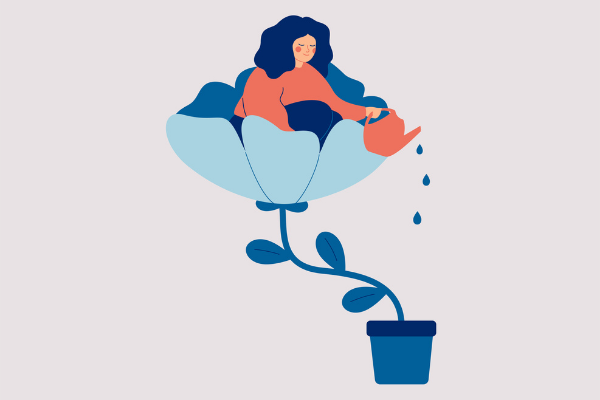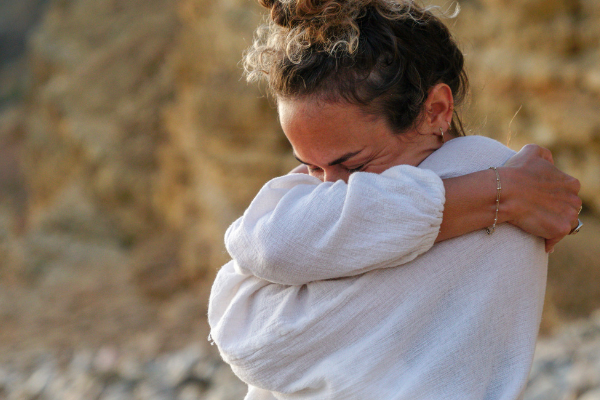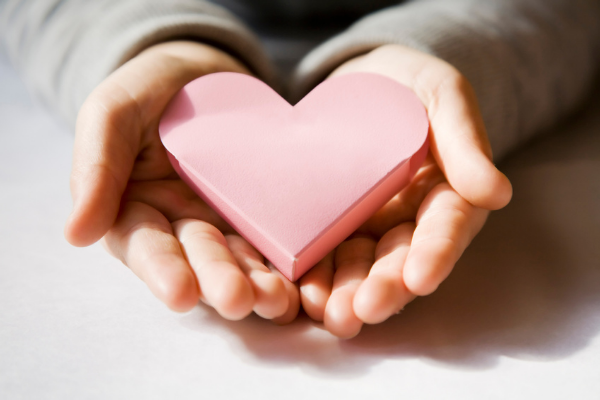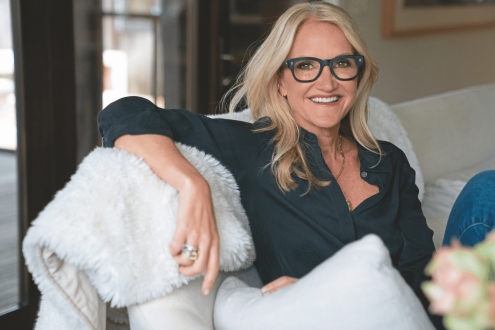How to be kind to yourself: Dossier Special
How do you speak to yourself when you fail, when you get things wrong or when you feel afraid? Learn how to become your own best friend and cultivate kindness and self-compassion in this special three part dossier...

Part One: A journey to self-compassion
We cry a resounding yes to self-kindness – but how do we learn it and why is it pivotal? Nicola Harker shares how the teachings of human development pioneer Kristin Neff altered the trajectory of her life.
Six years ago, I was a busy GP and mother of two young children. It never entered my head that I might change my job. I felt overloaded but accepted that was just how things were – tending the sick all day in frantically busy surgeries, racing to pick up my children and getting little sleep. I loved my job and expected to continue until I retired.
Looking back, of course my life was unsustainable – trying to be superwoman and please everyone – and I began to feel as if I wasn’t doing well in any area. I wasn’t depressed but was fatigued by decision-making and the weight of responsibility. I kept that to myself but sought answers to the malaise I felt.
Then, a coach friend mentioned a course in mindful self-compassion and asked me to join her. I was confused – why would I want to leave my children and spend five days in the Netherlands learning self-compassion? Words like self-indulgent and navel-gazing sprang to mind. I was a little offended – what did she see in me that she thought I needed the course?
For months, I did nothing, then I read Self Compassion (Hodder & Stoughton, £16.99), written by course leader Kristin Neff, an associate professor of educational psychology at the University of Texas. Neff is a big name in self-compassion. Her book is an easy read and she is honest about her struggle. I didn’t expect it to affect me so deeply and I couldn’t stop thinking about it. Learning about self-compassion challenged me deeply. I was exhausted, so the idea that I needed to learn something else – how to be kinder to myself – was not welcome. Then I started to wonder what my life might be like if I was self-compassionate, so I headed to Holland for training.
 The course was a turning point in my life and, although learning self-compassion is a lifelong journey, I have integrated what I learned into everything I do. By answering ‘how do I become self-compassionate?’ I have found an answer to burnout and a new career – and I have discovered so much about myself.
The course was a turning point in my life and, although learning self-compassion is a lifelong journey, I have integrated what I learned into everything I do. By answering ‘how do I become self-compassionate?’ I have found an answer to burnout and a new career – and I have discovered so much about myself.
‘Be self-compassionate; be kind to yourself.’ Sounds simple, doesn’t it? Yet, so many of us are resistant to being kind to ourselves and find it difficult. Neff shares that in research conducted in the United States, 78 per cent of people were more compassionate to others than themselves, six per cent were more compassionate to themselves than others and only 16 per cent were about equal. So, if we find self-compassion tricky, we are not alone.
“My biggest fear was that self-compassion was selfish, self-indulgent and weak.”
I worried about losing motivation and what others would think of me. These are among the many objections that naturally arise when considering being kind to yourself. Luckily, the research is reassuring – self-compassion makes you more likely to take responsibility for yourself, tackle self-development, own up to your mistakes, try new things and dare to fail – and it makes you more compassionate towards others.
So, if you decide to give it a go, how do you learn to be more self-compassionate?
Part Two: How to be kind to yourself and change your life
There are three key components to self-compassion, says Kristin Neff: awareness, common humanity – the idea that we all struggle and are not alone – and taking positive steps to support ourselves in that shared struggle. Let’s explore how we can put them into action.
1. What would you say to a friend?
The first step is awareness. Think about what you would say to a friend who is struggling, perhaps due to a relationship problem or a difficult boss at work. You might give them a hug, tell them it’s just a bad week, things will improve and they are a great person. You may make them a cup of tea and listen to them… Now consider what you do for yourself when you are struggling. Chances are that you give yourself a hard time, expect yourself to get over your pain or disappointment quickly and use self-critical language, such as ‘why do you always make a mess of things?’. Do you see the difference? You wouldn’t say those mean things to anyone else.
Be your own buddy
A useful tip when developing self-compassion in a difficult situation is to remember the prompt ‘what would I say to a friend?’, then practise giving yourself support. This may feel alien at first, but start by making a list of the things you already know make you feel better – a warm bath, a cup of tea, a hot-water bottle, a walk in nature, a shower, a cuddle with your dog or someone you love…
A common question that arises at this point is whether the list should include drinking a whole bottle of wine or eating an entire box of chocolates. These activities are about numbing painful feelings rather than soothing yourself. Try to stick to self-soothing methods that you won’t regret later.

2. Stay where you are
The next step is to practise noticing your emotions and simply being with them. Much of our impatience to ‘get over things’ is because we feel uncomfortable with our negative feelings but, in practice, if you can learn to notice your emotions and, instead of labelling them negatively, accept them and stay with them, you will move more speedily through the emotion.
‘What we resist, persists’ is true when you begin to notice your emotional states. The next time you feel angry, try taking cognisance of what is happening and say, for example: ‘I’m angry!’ and see what happens. The process of naming the emotion is calming and grounding.
I found this interesting, because I realised that I had swallowed the myth that life should be perfect and, if I was feeling negative emotions, I was failing somehow. I also had a binary approach to emotions: I was either fine or I wasn’t fine – which felt like a failure.
Self-compassion teaches us to lean in to difficult emotions, rather than try to avoid them. When you notice any painful emotion, try to acknowledge that all emotions are important and soothe yourself until it passes.
Sensations as signposts
When I was learning this, I realised that I had never considered self-soothing, even though we teach it to children. I was familiar with displacement activities and dismissing my feelings, but I had never thought that it would be a good idea to actively soothe myself in tough situations. So, how do you notice your emotions, stay with them and self-soothe? A good place to start is by becoming familiar with the sensations you experience in your body when you feel anger or shame, which helps you label the emotion as it arises.
It used to mystify me why I would suddenly feel like shouting at the dog or slamming the car door, but gradually I’ve learned that shame feels like a hot sensation in my chest or head, as if everything is speeding up. When I become aware of that, I now say: ‘This is shame. What do I need to do to help myself?’ It takes a little practice but I found that drawing a diagram of my body and mapping the sensations was useful. Once you have mapped ‘tricky’ emotions, you can identify when the connected sensations occur and become an expert at spotting when a challenging emotion is about to crop up.
The mindful part
A key component of self-compassion is mindfulness, which helps you stay aware, rather than being a passenger of your feelings and resorting to patterns of self-criticism. I thought having a mindfulness practice would involve me getting up at 4am or blocking out time in my overloaded day, which wasn’t practical. The self-compassion approach is down-to-earth: If you can manage a regular 10-minute mindfulness exercise, it’s better than nothing. There are simple mindfulness exercises you can do while cleaning your teeth, making a cup of tea or walking. You can even learn to use your breath to support yourself during challenging conversations. There are also grounding exercises that are helpful when you feel overwhelmed. Self-compassion involves building a toolbox of resources for any situation.
3. Find your inner coach
Self-criticism is a tall hurdle because many of us feel wedded to it. I used to believe that my inner critic kept me functioning at a high level but Neff’s research shows that our brain can’t tell the difference between external and internal criticism. When you tell yourself ‘I’m an idiot’, your brain experiences someone telling you ‘you’re an idiot’, which triggers a threat response deep in the amygdala. When you feel threatened, you tend to freeze, fight, hide or run away. This isn’t a brilliant way to motivate yourself! It’s more likely to result in procrastination, avoidance, blaming others or feeling stressed and depressed.
 For example, how do you feel when you’ve scuppered your health goals by eating too much cake? You start criticising yourself and, before you know it, you decide you may as well have more unhealthy food. Sound familiar? How do you break the cycle? Learning about the inner critic helped me understand that its intentions are to keep me safe. We all want to be socially acceptable, fit in and achieve – but the inner critic is like an annoying friend going about things the wrong way. Its nagging voice doesn’t have the intended effect and you feel worse.
For example, how do you feel when you’ve scuppered your health goals by eating too much cake? You start criticising yourself and, before you know it, you decide you may as well have more unhealthy food. Sound familiar? How do you break the cycle? Learning about the inner critic helped me understand that its intentions are to keep me safe. We all want to be socially acceptable, fit in and achieve – but the inner critic is like an annoying friend going about things the wrong way. Its nagging voice doesn’t have the intended effect and you feel worse.
A kind protector
Remember that self-compassion is also trying to keep you safe, which can help you change your inner dialogue. For example, perhaps I want to eat healthily, but slip up and berate myself over it, which makes me feel bad about myself. Using self-compassion, I might say to myself: ‘I want you to change your eating habits because I care about you and I don’t want you to harm your health. I know you want that too. What small steps can you take right now to get back on track?’
The first time I tried this, I realised that self-compassion isn’t about letting yourself off the hook over something, it’s about having an honest, supportive conversation with yourself – like being your own coach. It’s motivating, not shaming to be self-compassionate.
4. Sacrificial lamb syndrome
Self-compassion is also about boundaries. It took me by surprise to realise that my struggles with asking for what I wanted and setting boundaries were closely related to my lack of self-compassion. I discounted my needs and said yes to things because I wanted to be helpful or a team player, even to the point of self-sacrifice. When I started my self-compassion journey, I was close to burnout. It was difficult for me to consider changing my behaviour because I worried that I would be perceived as selfish. In reality, the outcome of having poor boundaries was that I became overwhelmed, overloaded and irritable.
People weren’t benefiting from my self-sacrifice and it took me a while to realise that self-compassion is a radical and courageous action. Learning to love myself deeply meant I didn’t need to seek outside approval. I could be helpful without sacrificing my wellbeing.
It’s not all down to me
Another concept also made me think: ‘Equanimity – having the wisdom to recognise the interconnected nature of life and the limitations of our own influence.’ I realised that I had become a fixer. I was a GP, so I was used to people expecting solutions from me, but I was also a daughter, wife and mother. It’s easy to assume responsibility for everyone and everything in life, and I’ve heard many people say ‘if you want it done properly, do it yourself’ – but the assumption that you are responsible for all outcomes and the purveyor of all the best ideas is a path to exhaustion. Self-compassion helped me develop the wisdom to see that I can offer to listen and ask if someone wants help, but I don’t have to assume responsibility, and many outcomes are beyond my control. This attitude is also more empowering to others.

5. Spark joy
An important ingredient of self-compassion, alongside being aware of our struggles and learning techniques to support ourselves with our emotions, is building our capacity for joy. I’d never thought about joy before, but it is something you can actively cultivate. You can practise savouring positive experiences; finding joy in little things – a shower, a snowdrop, a hug. You can practise gratitude every day in your journal and approach life recognising that circumstances change all the time; everything is transient, good and bad, and even awful situations can offer self-development and opportunities. It’s easy to gloss over this and forget that research indicates people who employ a simple gratitude practice are less likely to be depressed and report a better quality of life. As I developed a habit of savouring tiny, lovely things, I realised that it was an act of resistance against all the negativity in the world. And it felt subversive; secretly enjoying private experiences that made me smile.
The happy rebel
I loved clawing back joy as a conscious act of defiance, because life isn’t always exciting or easy. I realised that I had let my capacity for joy shrink under the weight of my responsibilities. I started a mission to grow my capacity for joy, one step at a time – by consciously noticing what I loved in life. My experiences are bigger now – the positives and the negatives in Technicolor. I am more aware and, at times, that is painful, but I also know that the pain will pass. Learning self-compassion is a courageous act. As the expert on courage, researcher and author Brené Brown, says: ‘I’m all in.’
Part Three: The distinctions of self-compassion
Psychology professor Kristin Neff summarises the mental flip sides of her research
SELF-COMPASSION COACHING COURSE
Self-kindness is life-changing and science backs that up. Former GP and coach, Nicola Harker has devised a four-week course, ‘The burnout antidote’, free to ‘Psychologies’ subscribers. Join us to access the course and other great benefits!
Photograph: Getty Images









